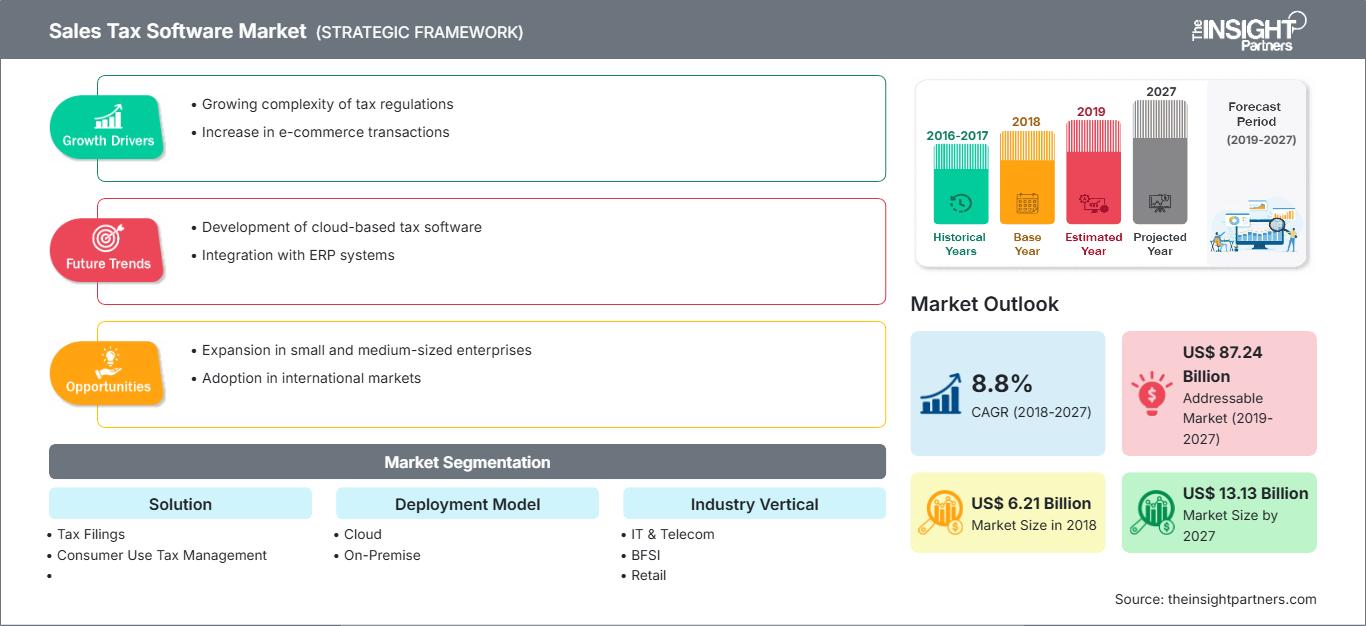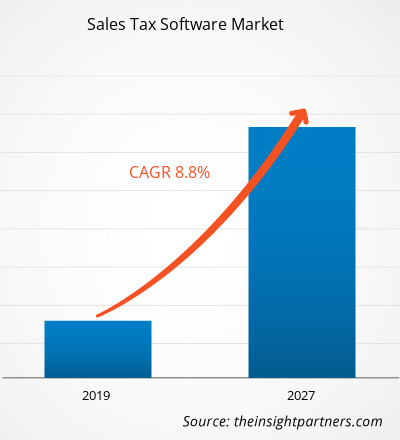[研究报告]2018 年销售税软件市场规模为 62.1 亿美元,预计在 2019 年至 2027 年预测期内,复合年增长率为 8.8%,到 2027 年将达到 131.3 亿美元。
在各个地理区域中,北美是领先的销售税软件市场,预计在整个预测期内将成为最高的收入贡献者。北美销售税软件市场的增长和采用主要受到零售、IT 和电信、交通运输和医疗保健等各个行业对销售税软件日益增长的需求的推动。
市场洞察专注于不断更新全球税法和法规
销售税和间接税是政府的主要收入来源,高效而详尽的税法有助于当局征收最大税收。随着全球跨境贸易和在线零售的蓬勃发展,以及电子商务和数字化等最新趋势的兴起,世界各地的税务机关都在不断更新税法和法规,以适应全球市场的最新发展。税法和法规变化的影响具有不确定性,且受多种因素影响,因此,企业需要投入大量资源来理解和改进其销售税的计算方法。由于人工参与,遗漏重要细节的风险很高,这可能导致计算错误并遭到税务机关的处罚。大型企业深知这一需求,并正在投资于销售税计算和申报流程的自动化,以减少人为错误。然而,中小型企业仍在适应自动化和数字化的理念。因此,不断变化的税法和法规预计将推动销售税软件市场的未来增长。
自定义此报告以满足您的要求
您将免费获得任何报告的定制,包括本报告的部分内容,或国家级分析、Excel 数据包,以及为初创企业和大学提供超值优惠和折扣
销售税软件市场: 战略洞察

-
获取本报告的主要市场趋势。这个免费样本将包括数据分析,从市场趋势到估计和预测。
这场席卷全球的数字化革命为企业提供了巨大的机遇,使其能够利用数字服务和自动化来转变其商业模式和现有流程,从而提高运营效率和收入。企业的数字化转型或数字化本质上是将数字技术融入各种业务流程、组织活动和商业模式。端到端业务流程优化、运营效率、降低成本和减少人为错误是任何行业数字化转型的主要驱动力。企业从传统流程向数字化和自动化流程的范式转变,为企业带来了多重益处,包括提高效率、降低成本和增加收入机会。此外,随着云计算和存储技术的进步,云平台的功能在过去十年中成倍增长。这进一步为企业选择基于云的销售税软件创造了新的机会。
组件洞察
按组件划分的全球销售税软件市场由税务确定和申报解决方案部门主导。合规文档管理解决方案在 2018 年占据销售税软件市场第二大份额,预计在 2019 年至 2027 年的预测期内,其份额将会增加。
部署类型洞察
按部署类型划分的全球销售税软件市场由云细分市场主导。公司更倾向于基于云的销售税软件,因为纳税申报表会自动备份到安全的服务器中。支持云的软件使企业无需对其技术基础设施进行大量投资即可快速扩展,因为云技术能够极大地适应加速的变化速度。它们能够适应动态的监管和报告环境。
行业垂直洞察
全球销售税软件市场按行业垂直细分为 BFSI、零售、IT 和电信、交通运输、医疗保健等。2018 年,零售业在全球销售税软件市场中占据最大收入份额,预计在 2019 年至 2027 年的预测期内将继续保持主导地位。 2027年。销售税软件市场的其他终端用户包括能源、制造业、教育和酒店业。
销售税软件市场的参与者主要致力于通过实施先进技术来增强产品性能。通过签署合作伙伴关系、签订合同、建立合资企业、融资以及在世界各地设立新办事处,该公司得以在全球范围内维护其品牌。以下列出了全球销售税软件市场的一些最新发展:
2019年:Sovos Compliance 与 Tytho 签署了战略合作协议,以巩固其在税务领域的领导地位,并协助实施 Sovos Compliance 解决方案并推广其产品。2017年:TaxJar 在 A 轮融资中从 Insight Venture Partners 获得了 6000 万美元。最近一轮 200 万美元融资由 Rincon Venture Partners 和 Daher Capital 于 2014 年领投。这笔资金将使该公司能够专注于产品开发和业务发展战略。2018 年:Ryan 扩大了与 Avalara 的联盟范围,为希望切换 ERP 系统以实现高效税务确定和报告的机动燃料公司提供咨询服务。
销售税软件市场区域洞察
Insight Partners 的分析师已详尽阐述了预测期内影响销售税软件市场的区域趋势和因素。本节还讨论了北美、欧洲、亚太地区、中东和非洲以及南美和中美洲的销售税软件市场细分和地域分布。
销售税软件市场报告范围
| 报告属性 | 细节 |
|---|---|
| 市场规模 2018 | US$ 6.21 Billion |
| 市场规模 2027 | US$ 13.13 Billion |
| 全球复合年增长率 (2018 - 2027) | 8.8% |
| 历史数据 | 2016-2017 |
| 预测期 | 2019-2027 |
| 涵盖的领域 |
By 解决方案
|
| 覆盖地区和国家 |
北美
|
| 市场领导者和主要公司简介 |
|
销售税软件市场参与者密度:了解其对业务动态的影响
销售税软件市场正在快速增长,这得益于终端用户需求的不断增长,而这些需求的驱动因素包括消费者偏好的不断变化、技术进步以及对产品优势的认知度不断提高。随着需求的增长,企业正在扩展其产品线,不断创新以满足消费者需求,并利用新兴趋势,从而进一步推动市场增长。

- 获取 销售税软件市场 主要参与者概述
- 税务确定与归档解决方案
- 合规文档管理解决方案
- 服务
按部署类型
- 云
- 本地
按行业垂直领域
- BFSI
- IT 和电信
- 零售
- 医疗保健
- 运输
- 其他
按地理位置
-
北美
- 美国
- 加拿大
- 墨西哥
-
欧洲
- 法国
- 德国
- 英国
- 俄罗斯
- 意大利
- 欧洲其他地区
-
亚太地区(亚太地区)
- 韩国
- 中国
- 印度
- 日本
- 澳大利亚
- 亚太地区其他地区
-
中东和非洲(MEA)
- 沙特阿拉伯
- 南非
- 阿联酋
- MEA其他地区
-
南美洲(SAM)
- 巴西
- 阿根廷
- SAM其他地区
公司简介
- APEX Analytix
- Avalara, Inc.
- Ryan, LLC
- The Sage Group Plc
- Sovos Compliance LLC
- Taxjar
- 汤森路透公司
- Vertex, Inc.
- Wolters Kluwer (CCH)有限公司)
- Xero 有限公司
- 历史分析(2 年)、基准年、预测(7 年)及复合年增长率
- PEST和SWOT分析
- 市场规模、价值/数量 - 全球、区域、国家
- 行业和竞争格局
- Excel 数据集
近期报告
相关报告
客户评价
购买理由
- 明智的决策
- 了解市场动态
- 竞争分析
- 客户洞察
- 市场预测
- 风险规避
- 战略规划
- 投资论证
- 识别新兴市场
- 优化营销策略
- 提升运营效率
- 顺应监管趋势






















 获取免费样品 - 销售税软件市场
获取免费样品 - 销售税软件市场